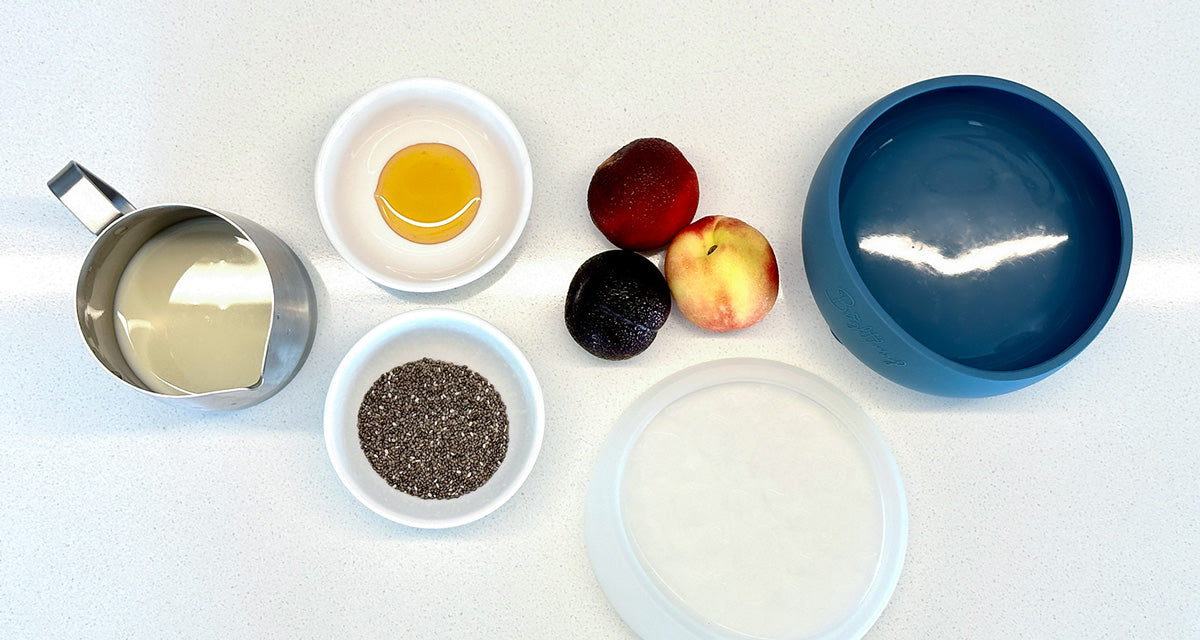Overnight Chia Pudding for Babies and Kids

Introducing your baby to solid foods is an exciting milestone filled with new experiences and flavours. One superfood that you might not have considered is chia seeds. These tiny nutritional powerhouses can be transformed into a delicious, easy-to-make, overnight chia pudding for babies. This guide will show you how to make and serve chia pudding for your toddlers and babies and store it overnight in a silicone suction bowl for a mess-free, enjoyable feeding experience.
Why Chia Pudding is Ideal for Babies and Toddlers
Nutritional Powerhouse
Chia seeds are rich in essential nutrients like omega-3 fatty acids, protein, fibre, and antioxidants, making them an excellent addition to your child’s diet. These nutrients support brain development, digestion, and overall growth, making chia pudding a nutritious option for babies and toddlers.
Perfect Texture for Little Ones
The soft, pudding-like texture of chia pudding is ideal for young eaters. It’s easy to chew and swallow, and you can customise the flavour by adding fruits, sweeteners, or spices that your child enjoys. The versatility of chia pudding also makes it an excellent way to introduce new tastes and textures to your baby.
Ingredients for Chia Pudding

Chia Seeds
These are the critical ingredients in chia pudding. You can find them in most supermarkets or health food stores. Both white and black chia seeds offer the same nutritional benefits, so you can choose based on availability.
Milk
Depending on your child's dietary needs and preferences, you can use any milk, such as cow’s, almond, soy, or coconut.
Sweetener
Adding a sweetener is optional. Honey (for children over one-year-old), maple syrup, or mashed ripe banana are excellent natural sweetness choices.
Flavourings
Customise your chia pudding with various flavourings, such as fresh fruits, a splash of vanilla extract, or a sprinkle of cinnamon. This helps keep the dish exciting and appealing for your child.
Step-by-Step Instructions for Making Chia Pudding for Babies

- Mix two (2) tablespoons of chia seeds, 1/2 cup of milk, and your sweetener in a Brightberry suction bowl.
- Stir the mixture well to ensure there are no clumps.
- Cover the bowl with a silicone lid and refrigerate for at least 2 hours or overnight.
- Before serving, stir the pudding again and top it off with your chosen flavourings.
- Serve directly in a Brightberry silicone bowl for a fuss-free and fun eating experience!
Tips for Making Perfect Chia Pudding Every Time
- Remember the golden ratio. 2 tablespoons of chia seeds to 1/2 cup of liquid. This will give you the perfect, spoonable consistency.
- Give your pudding enough time to set. Two hours is the minimum but overnight is best.
- Stir your chia pudding several times within the first hour of setting. This helps prevent clumping and ensures a smooth pudding.
Serving Chia Pudding To Babies
Benefits of Using Silicone Bowls
Serving chia pudding for babies in silicone bowls makes the whole preparation and eating process much easier and cleaner. These products are durable and safe and feature non-slip bases, which prevent spills and messes during mealtime. Silicone tableware is heat-resistant and easy to clean, making it ideal for busy parents.
Serving Tips
- Silicone Bowls: Serve chia pudding in silicone bowls with high walls to help young eaters scoop and eat more efficiently. Compared to plastic, silicone bowls are safer & more durable, minimising spills and allowing your child to focus on enjoying their meal.
- Silicone Cups: For a different serving option, pour the chia pudding into a silicone cup and let your child enjoy it like a smoothie. This is especially useful if your little one prefers to drink rather than eat with a spoon.
- Silicone Spoons: Use silicone spoons for a gentle, gum-friendly experience. These are ideal for babies just starting with solids and learning to self-feed.
More Kid-Friendly Chia Pudding Recipes
- Baby Custard – Custard is a smooth and creamy alternative to chia pudding. It can be made with simple ingredients and served in silicone bowls to minimise mess.
- Rice Pudding—Rice pudding is hearty and filling. It can be customised with your child’s favourite fruits or spices and served in silicone bowls for easy handling.
- Pumpkin Pudding – Packed with vitamins and has a unique, comforting flavour. It’s an excellent seasonal treat for kids.
- Banana Chia Pudding – Mash a ripe banana into the chia mixture before it sets. Add additional banana slices and a sprinkle of cinnamon for a tasty, nutritious treat.
- Berry and Coconut Chia Pudding – Add a handful of mixed berries and coconut milk to the chia pudding mixture. Once set, top with fresh berries for a colourful and delicious snack.
- Vanilla Coconut Chia Pudding – Use coconut milk instead of regular milk and add a dash of vanilla extract. This tropical version is sure to be a hit with your little one!
Frequently Asked Questions
Can I Give Chia Pudding to My Baby, Who is Just Starting Solids?
Yes, chia pudding is soft and easy to digest, making it suitable for babies starting solids. Introduce it in small amounts and monitor for any allergic reactions.
Do I Need to Grind Chia Seeds for Younger Babies?
Grinding chia seeds is not necessary as they soften when soaked in liquid. However, ground seeds may be easier to digest for younger babies or those with digestive concerns.
My Chia Pudding is Too Runny or Too Thick. What Should I Do?
If it’s too runny, add more chia seeds and let it sit longer. If it’s too thick, add more milk and stir well.
How Long Can I Store Leftover Chia Pudding in the Refrigerator?
Chia pudding can be stored in an airtight container in the refrigerator for up to 5 days. Ensure it is well-covered to maintain freshness and prevent it from absorbing other food odours.

















